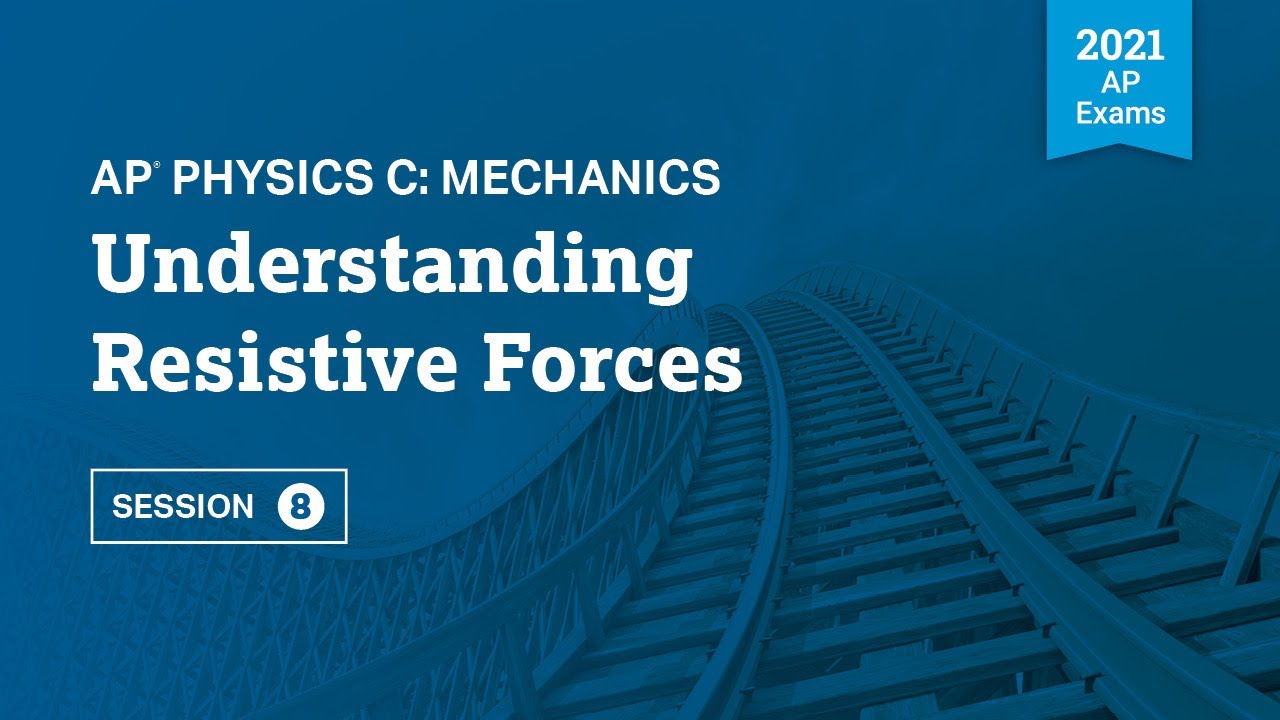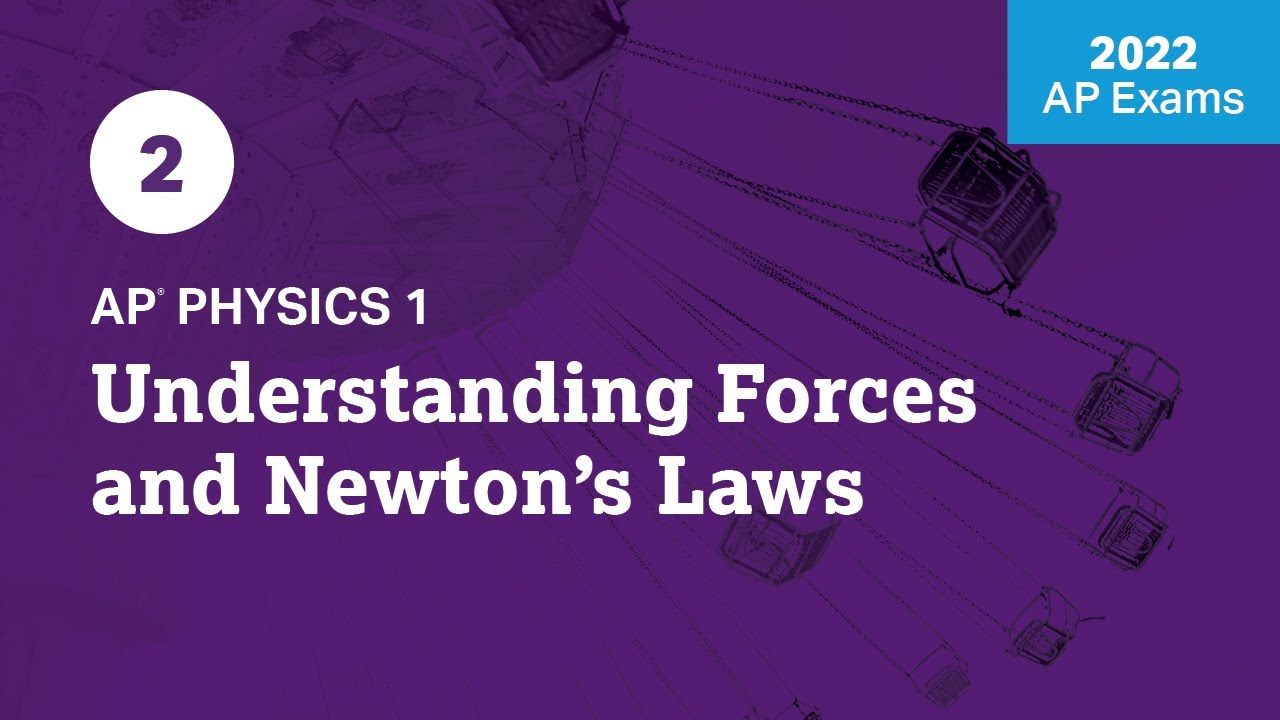Newton's Second Law - AP Physics 1: Dynamics Review Supplement
TLDRIn this educational video, the host engages in a review session of Newton's Second Law in preparation for the AP Physics 1 exam, utilizing multiple-choice problems. The session starts with a question on the force exerted by a falling rock on Earth, cleverly revealing it as a test of Newton's Third Law instead. The second problem involves calculating the magnitude and direction of an unknown force acting on an accelerating object, with a detailed explanation of the process. The third problem requires identifying free body diagrams that match specific motion criteria. Throughout, the host emphasizes the importance of understanding physics concepts deeply, as the AP exam often presents unconventional problems to test this understanding.
Takeaways
- 📚 The video is part of an AP Physics 1 Ultimate Review Packet, promoting a comprehensive resource for exam preparation.
- 🎓 The first question discusses Newton's Third Law, emphasizing the equal and opposite forces between the Earth and a falling rock.
- 🔍 The second question involves calculating the magnitude and direction of an unknown force (force 2) acting on an object with a given weight and acceleration.
- 📐 The solution to the second question uses Newton's Second Law to find the components of force 2 without initially drawing a free body diagram.
- 🧩 It's highlighted that the AP Physics exam may present problems that deviate from standard problem-solving patterns to test true understanding.
- 📉 The third question requires identifying free body diagrams that represent an object with constant velocity in the y-direction and constant acceleration in the x-direction.
- 📝 The process of solving the third question involves analyzing net forces in both x and y directions to match the object's motion as described.
- 📊 The video mentions the importance of understanding the Table of Information provided on the AP Physics exam, including common trigonometric values.
- 🌐 The script points out that forces like gravity and normal force are often implicit in exam problems and should be considered in real-world scenarios.
- 🎯 The final takeaway is the importance of recognizing that the last five questions on the AP Physics 1 exam may have two correct answers, requiring careful analysis.
- 👨🏫 The video features a collaborative learning approach with multiple individuals contributing to solving the physics problems.
Q & A
What is the main topic of the video?
-The main topic of the video is to solve three Newton's Second Law multiple-choice problems as a review for the AP Physics 1 exam.
What does the weight of the rock represent in the context of the first question?
-In the context of the first question, the weight of the rock (capital W) represents both the force of gravity acting on the rock and the force the Earth applies on the rock.
According to Newton's Third Law, what is the relationship between the force the Earth applies on the rock and the force the rock applies on the Earth?
-According to Newton's Third Law, the force the rock applies on the Earth is equal in magnitude but opposite in direction to the force the Earth applies on the rock.
What is the mass of the 300-newton object in the second question, assuming standard gravity?
-The mass of the 300-newton object is approximately 30 kilograms, calculated using the formula mass = force of gravity / acceleration due to gravity (300 N / 10 m/s²).
In the second question, what is the acceleration of the object in the x-direction?
-The acceleration of the object in the x-direction is zero because the object is not accelerating in that direction.
What is the magnitude and direction of force 2 in the second question, according to the solution?
-The magnitude of force 2 is 50 newtons, and its direction is at an angle of 37 degrees North of West.
Why is it important to be familiar with the Table of Information provided by the College Board for the AP Physics exam?
-It is important to be familiar with the Table of Information because it provides values of trigonometric functions for common angles, which can be useful for solving problems on the AP Physics exam.
What is the significance of the grid in the free body diagrams presented in the third question?
-The grid in the free body diagrams helps to determine the magnitudes of the vectors and the magnitudes of the components of the vectors, assisting in visualizing and solving the problem.
In the third question, what criteria should the correct free body diagrams meet?
-The correct free body diagrams should show zero net force in the y-direction and a nonzero net force in the x-direction, corresponding to constant velocity in the y-direction and constant acceleration in the x-direction.
Which choices in the third question correctly represent the object's conditions as described?
-Choices A and D correctly represent the object's conditions, showing zero net force in the y-direction and a nonzero net force in the x-direction.
Outlines
📚 AP Physics 1 Review: Newton's Second Law Problems
This paragraph introduces a video script designed to review Newton's Second Law in preparation for the AP Physics 1 exam. It is part of a larger review packet available on a dedicated website. The script involves a multiple-choice question about a freely falling rock and the force it exerts on Earth. The correct answer, choice B, is explained using Newton's Third Law, which states that for every action, there is an equal and opposite reaction. The weight of the rock (capital W) is both its force of gravity and the force the Earth applies on the rock, which is mirrored by the force the rock applies upwards on the Earth.
🔍 Solving Force and Motion Problems for AP Physics
The second paragraph delves into solving a physics problem involving an object accelerating northward with a force acting eastward. The goal is to determine the magnitude and direction of a second force acting on the object. The solution involves calculating the object's mass using its weight and the acceleration due to gravity, then applying Newton's Second Law to find the components of the second force in both the x and y directions. The problem tests the understanding of vector components and the resultant force, leading to the conclusion that the second force has a magnitude of 50 newtons at an angle of 37 degrees north of west, corresponding to choice A.
📐 Analyzing Free Body Diagrams for Constant Velocity and Acceleration
The final paragraph of the script focuses on analyzing free body diagrams to determine which could represent an object with constant velocity in the y-direction and constant acceleration in the x-direction. The explanation involves understanding that a net force of zero in the y-direction and a nonzero net force in the x-direction are required. The paragraph guides through the process of eliminating incorrect choices and identifying the correct free body diagrams that meet the criteria. It emphasizes the importance of recognizing the need to identify both correct answers in multiple-choice questions on the AP Physics exam, which is a key strategy for success.
Mindmap
Keywords
💡Newton's Second Law
💡AP Physics 1
💡Weight
💡Force of Gravity
💡Newton's Third Law
💡Acceleration
💡Free Body Diagram
💡Magnitude
💡Direction
💡Trigonometric Functions
💡Net Force
Highlights
Introduction to Newton's Second Law multiple-choice problems for AP Physics 1 exam review.
Explanation of the force from a freely falling rock on the Earth, involving Newton's Third Law.
Clarification that the force from the rock on the Earth is equal and opposite to the Earth's force on the rock.
Discussion on the weight of the rock being the force of gravity and its application in Newton's Third Law.
Problem-solving approach for a 300-newton object accelerating north with an eastward force.
Calculation of the object's mass using gravity and acceleration due to gravity.
Identification of the y-component of force 2 causing the object's northward acceleration.
Explanation of the x-component of force 2 balancing out the eastward force.
Use of the Pythagorean theorem to find the magnitude of force 2.
Determination of the direction of force 2 using trigonometric functions.
Highlight of the importance of understanding physics concepts for unusual problem setups.
Advice on reviewing the Table of Information for common trigonometric values before the exam.
Introduction of a problem involving constant velocity in y-direction and constant acceleration in x-direction.
Analysis of free body diagrams to find the correct ones showing the specified motion.
Instruction on identifying two correct answers for multiple-choice questions on the AP Physics exam.
Solution process for determining the correct free body diagrams based on net forces.
Conclusion and appreciation for the learning session with the audience.
Transcripts
Browse More Related Video

AP® Physics 1: Forces and Newton's Laws (Unit 2)

AP Physics 1 Dynamics Review

2021 Live Review 8 | AP Physics C: Mechanics | Understanding Resistive Forces

AP Physics B - 2013 #1 (Fluids - Bouyancy)

2022 Live Review 2 | AP Physics 1 | Understanding Forces and Newton’s Laws

Net Force Physics Problems With Frictional Force and Acceleration
5.0 / 5 (0 votes)
Thanks for rating: